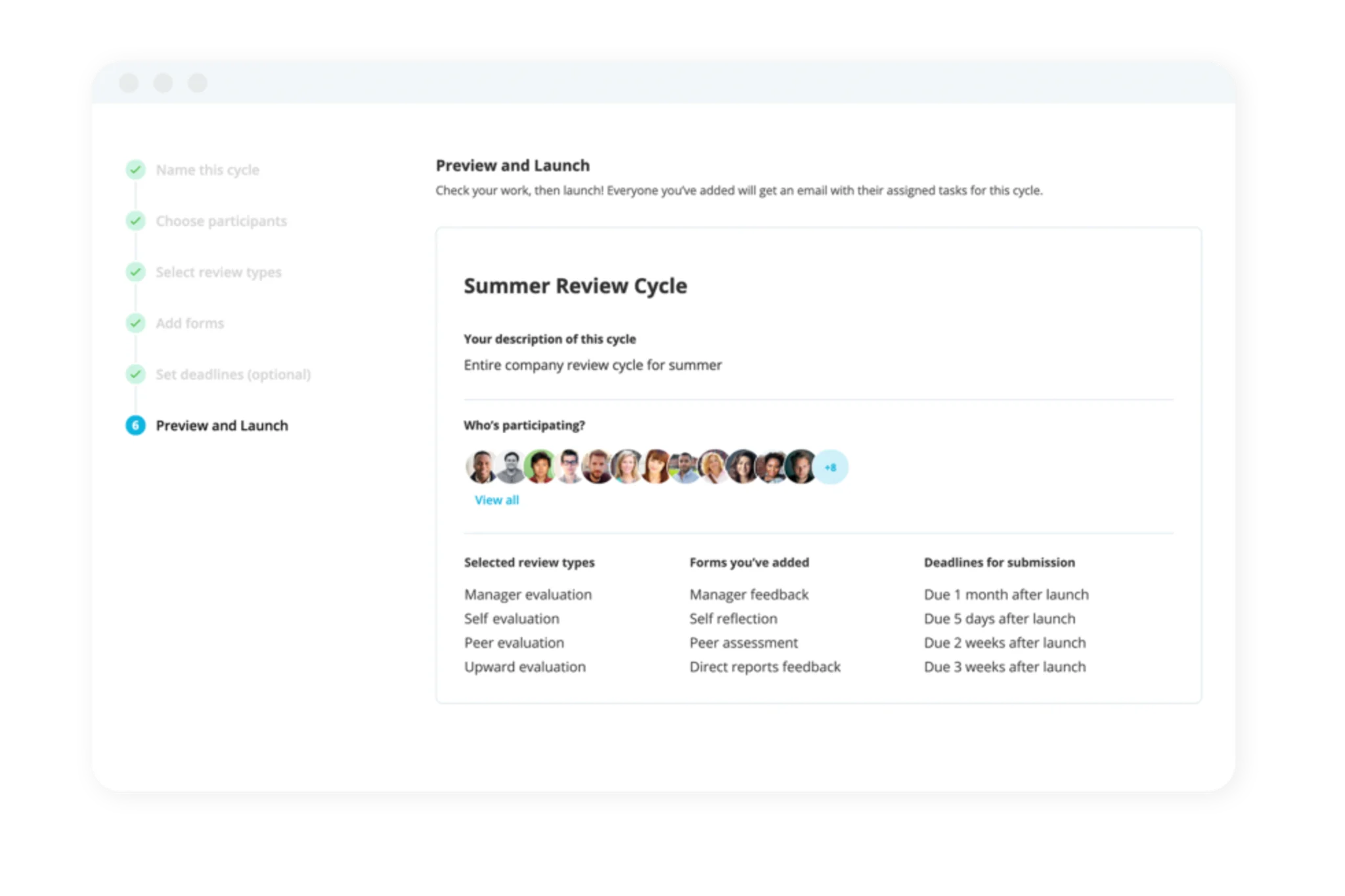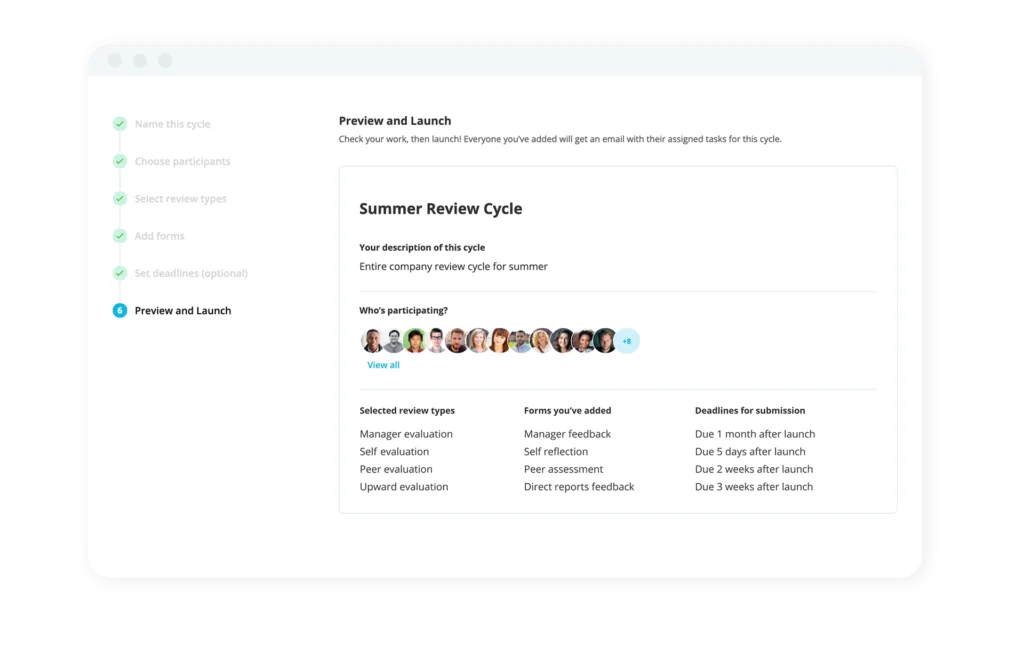Benefits of Coaching in the Workplace
Workplace coaching can be a highly beneficial way of improving the performance of employees, teams, and the organisation overall. Here’s our guide to the different types of coaching in the workplace, the benefits of a coaching program, and how to get started.
Start from the top with our performance review template today.What is Coaching in the Workplace?
Workplace coaching (sometimes referred to as employee coaching or business coaching) is a feedback arrangement where a coach helps an individual employee or team work on areas of improvement to improve performance over time.
Coaching in the workplace is a great way to set employees up for success. Coaches can help workers increase their skills and knowledge, either through direct teaching or giving employees the tools to do it themselves.
There are many types of coaching in the workplace, including:
Performance coaching
Executive/leadership coaching
Team coaching
Career coaching
Skills coaching
Virtual coaching
The Benefits of Coaching in the Workplace
Workplace coaching can have positive benefits for the individual or team being coached, as well as for the coach and the organisation at large. Here are some top benefits for teams and individuals.
Benefits of Coaching for Individuals
Prioritising and investing in coaching for individuals can pay dividends both in the short and long term. Whether this coaching happens via a manager, mentor, or dedicated coach, benefits can include:
Improvements in performance
Development of new skills
More interest in Learning & Development
Boost in positive attitude at work
Easier acceptance of feedback and openness to change
Improved “solution” mindset for solving problems
Better understanding of job requirements, objectives, and expectations
Increased ability to take ownership over responsibilities
Benefits of Coaching for Teams
Within high-performing teams, the impact of individuals tends to multiply so that the team itself is even more effective than the sum of its parts. But according to Mye Coach, less than 10% of teams would say they are high performing before beginning team coaching.
Coaching for teams can help the individuals that make up the group to develop more trust, transparency, respect, and commitment, thereby boosting their overall performance.
One of the best parts of coaching for teams is that it gives members a feeling that they’re “all in this together” – a sentiment that can improve employee engagement and satisfaction in the workplace while also boosting productivity and decreasing turnover.
Benefits of Coaching for Organisations
Organisations with a culture of coaching are likely to experience significant benefits at all levels. There will be payoffs for individuals and teams, but also for the organisation as a whole:
Increase productivity, efficiency, and effectiveness
Improve employee motivation, engagement, and morale
Develop talent to reach their potential in the organisation
Demonstrate commitment to learning and development
Create an environment of learning and knowledge sharing across teams and departments
Build sustainable culture and leadership style
Foster better relationships and communication
Increase retention
Decrease talent acquisition spending
With better performance among individuals and teams, the organisation will also improve its overall performance and results at the bottom line.
How to Introduce Coaching Into Your Organisation
When introducing coaching, it’s crucial to get the process right and to know it won’t happen overnight. There’s a lot at stake, on top of all the benefits listed above. According to leadership expert Francois Coetzee, an organisation that utilises training and coaching can experience an 88% increase in productivity, compared to 23% from training alone.
There are a variety of ways to start implementing coaching in your organisation. You could hire an external coach, start an internal program with coaching from leadership, or ask for volunteers. There’s no right way to do it; every organisation is different.
However, there are a few things that should happen no matter the setup of the coaching program.
For starters, prioritise feedback across all stakeholders. Employees should be receiving feedback regularly, but they should also be empowered to give feedback to their leaders, coaches, and experience in the company overall. Ensuring the organisational culture encourages constructive feedback can have a major impact on the success of a coaching program.
Additionally, remember that not everyone finds it easy to ask for help, so empathy is key. Create an open conversation among employees at all levels to make it clear that coaching is available and encouraged (or required if that’s the route you’re going).
How Personio Supports the Benefits of Coaching
Personio is built to save HR teams time so they can focus on value-add activities like coaching rather than manual paperwork. Additionally, our Performance Management Software offers a transparent place to store 360º feedback, reviews, and progress. It can even be tied to certain goals that come out of coaching.
Happy, satisfied employees are not only a tribute to the effectiveness of an HR team – they’re necessary for productivity and long-term company success.
Frequently Asked Questions on Workplace Coaching
What Is an Example of Coaching at Work?
One example of coaching at work is performance coaching. Let’s say an employee works in sales and is continuously struggling to reach their quota. A coach could help them with tips to improve their productivity, time management, soft skills, and more.
With this type of coaching, the coach can help an employee improve their job performance over time by helping them set goals, monitoring their progress, and giving them the tools they need to succeed.
How Can You Use Coaching in the Workplace?
Organisations can use coaching in the workplace to improve the performance, skillset, or even attitudes of individual employees and teams. Building a coaching program can help employees to develop over time, which in turn improves the performance and culture of the overall organisation.
Why Does Coaching in the Workplace Work?
Coaching in the workplace is effective because every single employee, team, and organisation has opportunities for improvement. No one is perfect, and creating a coaching program helps each employee participant to reach their full potential, increasing the performance of the whole organisation.
How Do You Start Coaching an Employee?
Coaching an employee effectively requires the coach to be communicative, to personalise their coaching, and to have a solid plan in place.
Communicate – A coaching engagement shouldn’t just involve the coach talking at the employee. In fact, the majority of talking should be on the employee side with the guidance of the coach or supervisor. It’s best if the coach can help the employee to realise their opportunities for improvement on their own.
Personalise – Every employee is different, and their development needs are different, too. Coaches should do their best to discover the unique aspects of past performance in order to develop an action plan to improve future performance.
Plan – Coaches need to plan how the coaching engagement will work, from how often they’ll meet to what areas of development will be worked on. (FYI: More frequent is usually better.) Help the employee define their SMART action plan – Specific, Measurable, Attainable, Relevant, and Timely.


